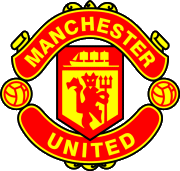
MANCHESTER UNITED F.C.
Founded: 1878
Also Known As:
NEWTON HEATH LYR (1878-1902)
MANCHESTER UNITED (1902-)
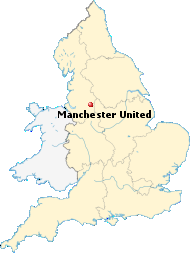
CLICK ON THE MAP TO
VIEW ENLARGED MAP
|
MANCHESTER UNITED F.C. (Football Club)
Included Info: Brief History, Club/Stadium Info, Team Jersey & Much More...
BRIEF HISTORY of MANCHESTER UNITED FOOTBALL CLUB
(reproduced from 'Wikipedia' pages)
Manchester United was formed in 1878 as Newton Heath LYR Football Club by the Carriage and Wagon department of
the Lancashire and Yorkshire Railway (LYR) depot at Newton Heath. By 1888, the club had become a founding member
of The Combination, a regional football league. Following the league's dissolution after only one season, Newton
Heath joined the newly formed Football Alliance, which ran for three seasons before being merged with the Football
League. This resulted in the club starting the 189293 season in the First Division, by which time it had become
independent of the rail company and dropped the "LYR" from its name. After two seasons, the club was relegated to
the Second Division. In January 1902, with debts of £2,670 the club was served with a winding-up order. Captain
Harry Stafford found four local businessmen, including John Henry Davies (who became club president), each willing
to invest £500 in return for a direct interest in running the club and who subsequently changed the name; on 24
April 1902, Manchester United was officially born. Under Ernest Mangnall, who assumed managerial duties in 1903,
the team finished as Second Division runners-up in 1906 and secured promotion to the First Division, which they
won in 1908 the club's first league title. The following season began with victory in the first ever Charity
Shield and ended with the club's first FA Cup title. Manchester United won the First Division for the second time
in 1911, but at the end of the following season, Mangnall left the club to join Manchester City.
In 1922, three years after the resumption of football following the First World War, the club was relegated to the
Second Division, where it remained until regaining promotion in 1925. Relegated again in 1931, Manchester United
became a yo-yo club, achieving its all-time lowest position of 20th place in the Second Division in 1934. Following
the death of principal benefactor John Henry Davies in October 1927, the club's finances deteriorated to the extent
that Manchester United would likely have gone bankrupt had it not been for James W. Gibson, who, in December 1931,
invested £2,000 and assumed control of the club. In the 193839 season, the last year of football before the Second
World War, the club finished 14th in the First Division. In October 1945, the impending resumption of football led
to the managerial appointment of Matt Busby, who demanded an unprecedented level of control over team selection,
player transfers and training sessions. Busby led the team to second-place league finishes in 1947, 1948 and 1949,
and to FA Cup victory in 1948. In 1952, the club won the First Division, its first league title for 41 years.
In 1957, Manchester United became the first English team to compete in the European Cup, despite objections from
The Football League, who had denied Chelsea the same opportunity the previous season. En route to the semi-final,
which they lost to Real Madrid, the team recorded a 100 victory over Belgian champions Anderlecht, which remains
the club's biggest victory on record. The following season, on the way home from a European Cup quarter-final
victory against Red Star Belgrade, the aircraft carrying the Manchester United players, officials and journalists
crashed while attempting to take off after refuelling in Munich, Germany. The Munich air disaster of 6 February 1958
claimed 23 lives, including those of eight players.
Busby rebuilt the team through the 1960s by signing players such as Denis Law and Pat Crerand, who combined with the
next generation of youth players including George Best to win the FA Cup in 1963. The following season, they
finished second in the league, then won the title in 1965 and 1967. In 1968, Manchester United became the first
English (and second British) club to win the European Cup, beating Benfica 41 in the final. Matt Busby resigned as
manager in 1969 and was replaced by the reserve team coach. Manchester United won the FA Cup twice in three years
in 1983 and 1985. In 198586, after 13 wins and two draws in its first 15 matches, the club was favourite to win
the league, but finished in fourth place. The following season, with the club in danger of relegation by November,
United manager Ron Atkinson was dismissed. Alex Ferguson and his assistant Archie Knox arrived from Aberdeen on the
day of Atkinson's dismissal, and guided the club to an 11th-place finish in the league. Despite a second-place finish
in 198788, the club was back in 11th place the following season. In 1993, the club won its first league title since
1967, and a year later, for the first time since 1957, it won a second consecutive title alongside the FA Cup
to complete the first "Double" in the club's history. In the 199899 season, Manchester United became the first team
to win the Premier League, FA Cup and UEFA Champions League "The Treble" in the same season. Losing 10 going
into injury time in the 1999 UEFA Champions League Final, Teddy Sheringham and Ole Gunnar Solskjær scored late goals
to claim a dramatic victory over Bayern Munich, in what is considered one of the greatest comebacks of all time.
The club also won the Intercontinental Cup after beating Palmeiras 10 in Tokyo. Ferguson was subsequently knighted
for his services to football.
Manchester United won the league again in the 19992000 and 200001 seasons. The team finished third in 200102,
before regaining the title in 200203. They won the 200304 FA Cup, beating Millwall 30 in the final at the
Millennium Stadium in Cardiff. In the 200506 season, Manchester United failed to qualify for the knockout phase
of the UEFA Champions League for the first time in over a decade, but recovered to secure a second-place league finish
and victory over Wigan Athletic in the 2006 Football League Cup Final. The club regained the Premier League in the
200607 and 200708 seasons, and completed the European double by beating Chelsea 65 on penalties in the 2008 UEFA
Champions League Final in Moscow's Luzhniki Stadium. Ryan Giggs made a record 759th appearance for the club in this
game, overtaking previous record holder Bobby Charlton. In December 2008, the club won the 2008 FIFA Club World Cup
and followed this with the 200809 Football League Cup, and its third successive Premier League title. That summer,
Cristiano Ronaldo was sold to Real Madrid for a world record £80 million. In 2010, Manchester United defeated Aston
Villa 21 at Wembley to retain the League Cup, its first successful defence of a knockout cup competition. After
finishing as runner-up to Chelsea in the 200910 season, United achieved a record 19th league title in 201011,
securing the championship with a 11 away draw against Blackburn Rovers on 14 May 2011. This was extended to 20
league titles in 201213, securing the championship with a 30 home win against Aston Villa on 22 April 2013.
|
CLUB FACTS & INFORMATION
| Official Name
| --
| Manchester United F.C. |
| Club Nickname
| --
| The Red Devils |
| Year Founded
| --
| 1878 (139 years ago) |
| English County
| --
| Greater Manchester |
| Current Ground
| --
| Old Trafford |
| Ground Location
| --
| Old Trafford, England |
| Club's Owner
| --
| Manchester United plc
(NYSE: MANU) |
| Club Co-Chairmen
| --
| Joel and Avram Glazer |
| Current Manager
| --
| José Mourinho |
| Current League
| --
| Premier League |
| Last Season
| --
| Premier League, 6th place |
HOME COLORS

Red & White |
AWAY COLORS

White & Black
w/Red Trim |
|
| |
INTERESTING STADIUM FACTS & INFORMATION

OLD TRAFFORD
Sir Matt Busby Way, Old Trafford,
Manchester, M16-0RA, England
OPENED: ......... February 19, 1910
SURFACE: ........ Desso GrassMaster
COST: .............. £90,000 (1909)
CAPACITY: ...... 75,643
RECORD: ......... 83,260 (1948 vs Arsenal)
OWNER: ........... Manchester United F.C.
OPERATOR: ..... Manchester United F.C.
FIELD SIZE: ..... 115 x 74 yards (105 x 68 meters)
|
|
|
HOME JERSEY
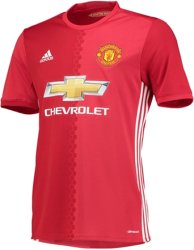 |
AWAY JERSEY
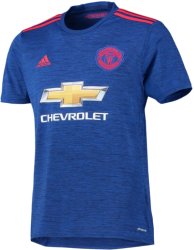 |
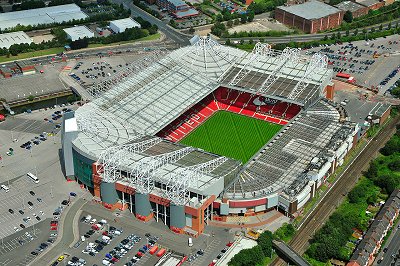
Click On Aerial Photo To View/Download Enlarged Image
|
Old Trafford (Manchester United) Seating Diagram
Click On Diagram Below To Enlarge View
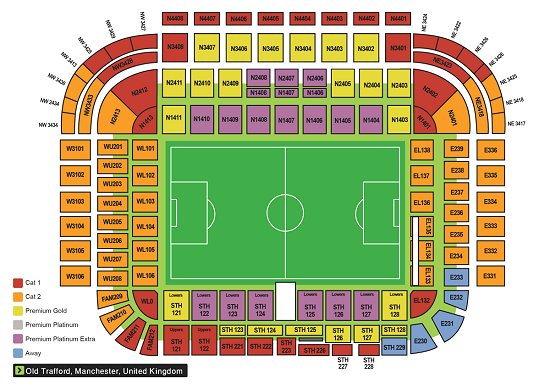
|



MANCHESTER UNITED STADIUM WALLPAPERS (Free Download)
Wallpaper Size below is 800x600: To Download Bigger Sizes, Click On Any Button Shown Above
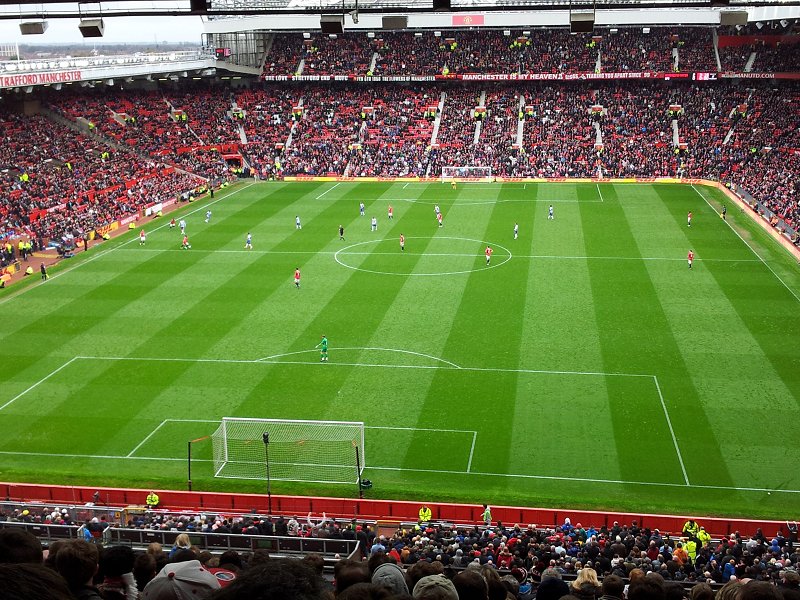
|
|

